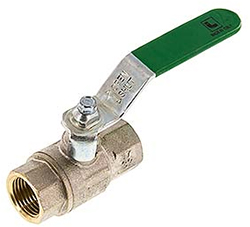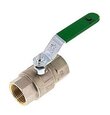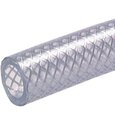Valves, Pipes, and Hoses for Drinking Water

Figure 1: Brass ball valve with a drinking water certification
Maintaining the purity of drinking water necessitates the meticulous selection of its contact components, such as valves, pipes, hoses, and fittings. These components must adhere to specific material standards and comply with regional drinking water certifications to avoid contamination and protect health. This article explores the significance of selecting appropriate valves, hoses, and pipes for drinking water, highlighting the importance of products that meet rigorous health and safety standards.
Table of contents
- Valves for drinking water applications
- Water pipes and hoses
- Importance in water systems
- Certification and regulation
- Selection criteria
- Additional considerations
View our online selection of drinking water hoses and valves!
Valves for drinking water applications
Water shut off valves
A water shut-off valve is designed to stop water flow in plumbing systems, essential for repairs or emergencies. The main shut-off valve controls the entire house's water supply, while individual valves located near appliances and along branching lines allow for isolating specific sections. The most common types include ball valves, known for their reliability, and ball, gate, globe, and angle seat valves, each suited for specific applications in controlling water flow to fixtures.
Check valves for water
Check valves for water are also called ‘backflow preventers’ as they prevent the backflow of water. Typically, these are required by plumbing codes to prevent the backflow of contaminated water into the potable water source. Check valves are also used on private well systems to keep the water in the pressure tank and to keep the pump primed. Spring loaded check valves are the most commonly used as they are cheap, close quickly but still prevent water hammer, and have good sealing properties.Water solenoid valves
Drinking water solenoid valves play a pivotal role in managing the intermittent water supply needs of various appliances within a building, such as dishwashers and washing machines. These valves operate by opening to allow water flow from the main line when the appliance is activated and closing to halt the flow once the water is no longer needed. The efficiency of solenoid valves lies in their quick operation, reliability, and effective sealing capabilities, making them an ideal choice for controlling water access in automated systems.
While solenoid valves are generally efficient, their rapid action can sometimes lead to water hammer. To mitigate this risk, it is advisable to opt for solenoid valves with adjustable closing times. Such valves, known as slow closing water solenoid valves, are designed to gradually stop water flow, thereby reducing the chances of water hammering and ensuring the longevity of the plumbing infrastructure.
Float valve for water tanks
Float valves in drinking water tanks regulate the water level by opening to allow water in when the level is low and closing to stop the inflow when the tank is full. This automatic operation ensures a consistent water level, preventing overflow or depletion. They are essential for maintaining an adequate and steady water supply in storage tanks.
Water pipes and hoses
Water pipes and hoses transport water between two points. For main water lines, pipes are used as they are more durable. However, for a water supply that needs to be flexible, like a garden hose, connection to a machine, or in a warehouse, a hose is used and having it flexible allows for it to be moved more easily.
Importance in water systems
Valves, pipes, and hoses must be carefully selected, installed, and maintained to prevent contamination, ensure durability, and minimize water loss.
-
Water quality: The quality of water can be significantly influenced by the materials used in valves, pipes, and hoses. It's essential to choose materials that ensure the safety and purity of water. Here are key considerations for selecting materials that positively impact water quality:
- Non-leaching materials: Choose materials that do not release harmful substances into the water. Certain metals, when used in plumbing, can contaminate water by leaching.
- Neutral impact on water: Materials should be chosen based on their ability to be neutral in taste, smell, and color. They should also be resistant to ozone and chemicals used in water treatment processes.
- Bacterial growth prevention: The materials used should not encourage the growth of bacteria or the formation of biofilm. This helps in ensuring that the water remains uncontaminated.
- Low lead content: Given the health risks associated with lead, the lead content in these materials is rigorously tested. This is to ensure they are safe for transporting drinking water.
- Sterilization of hoses: Hoses for drinking water must undergo sterilization to eliminate any potential contaminants, ensuring the water's safety for consumption.
- Corrosion resistance: The chemistry of the transported water can affect the corrosion potential of pipes and fittings. For instance, acidic water (low pH) can increase the risk of metal leaching. Therefore, selecting materials that are compatible with the local water chemistry is vital to prevent corrosion and ensure water quality.
- Pressure and flow: Properly functioning valves are crucial for controlling water pressure and flow within the system. Excessive pressure can lead to pipe bursts, while insufficient pressure can cause backflow, introducing contaminants into the water supply.
- System integrity: The durability and compatibility of these components with the water and environmental conditions (e.g., soil characteristics for buried pipes) are critical for the long-term integrity of the water distribution system. Material degradation can lead to leaks, bursts, and contamination.
Certification and regulation
Here is a list of most commonly known certifications and regulations applicable to water valves, pipes, and hoses.

Figure 2: Certifications for drinking water
Kiwa Water Mark
The Kiwa water mark is for products that come into contact with drinking water for the Dutch market. This single mark allows for producers and suppliers to only deal with one set of requirements.
NSF (National Sanitation Foundation) – North America
In North America, water treatment or distribution products such as valves, gaskets, pipes and hoses are recommended and, in most states, required to comply with NSF/ANSI 61.
WRAS (Water Regulations Advisory Scheme) – Great Britain
All water fittings in contact with the public mains water supply must comply with Water Supply Regulations in UK or Scottish Byelaws. WRAS provides quality testing for products and materials to demonstrate full compliance with these regulations and byelaws. The scheme consists of material safety and mechanical testing.
KTW/W270 – Germany
KTW is a guideline on the hygienic assessment of organic materials such as plastics and silicones in contact with drinking water, and W270 describes a method for the assessment of microbial growth on non-metallic materials in contact with drinking water. The DVGW (Deutscher Verein des Gas- und Wasserfaches) provides the required testing and certification for these products.
ACS (Attestation De Conformite Sanitaire) – France
The ACS is a material safety approval mandatory for all materials and products in contact with drinking water in France.
WaterMark – Australia and New Zealand
WaterMark certification scheme is a mandatory certification for plumbing and drainage products for sale in Australia and New Zealand.
Selection criteria
Selecting the appropriate valves, pipes, and hoses for drinking water systems is crucial for ensuring the safety, efficiency, and longevity of the water supply.
- Temperature: Certain materials are not suitable for hot water applications. For example, traditional PVC pipes are generally unsuitable for hot water, whereas CPVC (chlorinated polyvinyl chloride) can handle higher temperatures, making it a better choice for hot water lines.
- Durability and lifespan: The expected lifespan of the components under normal operating conditions is a critical factor. This includes considerations of wear and tear, corrosion resistance, and resilience to environmental factors such as UV exposure for outdoor applications.
- Ease of installation and maintenance: Components should be selected based on the ease of installation and the maintenance they require over their lifespan. For example, materials that require less frequent replacement or are easier to repair can reduce long-term costs and system downtime.
- Environmental and health regulations: All components used in drinking water systems must comply with relevant standards to ensure they do not pose a risk to water quality or public health. These hoses and pipes are subject to various regulations to maintain water quality. This includes standards for material safety, such as NSF/ANSI 61, which certifies that the materials used do not contaminate drinking water. In Europe, the main governing regulation is the Drinking Water Directive (98/83/EC) and in the USA the main regulation is the Safe Drinking Water Act (SDWA).
-
Material compatibility: The compatibility of materials with each other and with the water being transported is essential to prevent corrosion, degradation, and contamination. For instance, mixing copper and certain steel types without proper precautions can lead to galvanic corrosion.
-
Valve body materials:
- Standard brass: Meets European drinking water standards but often contains lead, posing challenges for North American regulations which demand calculations for lead content.
- Lead-free brass: Used in products like water solenoid valves, offering a safer alternative without compromising functionality.
- Composite and plastic: Completely lead-free, favored in both commercial and residential settings despite being slightly pricier than metal options.
- Stainless steel: Lead-free, versatile in terms of flow, size, temperature, and pressure capabilities, but generally more expensive.
-
Valve seal materials:
- NBR (Nitrile Buna Rubber): Common for drinking water valves, withstands temperatures from -18°C to +90°C (-0.4°F to 194°F), suitable for neutral fluids.
- EPDM (Ethylene Propylene Diene Monomer): Offers higher heat resistance (up to 120°C or 248°F), ideal for both cold and hot water applications.
-
Pipes:
- PVC (polyvinyl chloride): Lightweight, corrosion-resistant, ideal for cold water only.
- HDPE (high-density polyethylene): Flexible, corrosion and chemical-resistant, used for underground water mains.
- Copper: Durable, reliable for hot and cold water, inhibits bacterial growth.
- Stainless steel: Corrosion-resistant, withstands high pressures, more costly but durable.
-
Hoses:
- Reinforced rubber: Versatile for various temperatures and pressures, suitable for flexible connections.
- PVC hoses: Affordable, available in drinking water grades, versatile in application.
- Polyurethane: Flexible, durable, and high-quality, ideal for drinking water standards.
-
Valve body materials:
Read our chemical compatibility chart for more details on the compatibility of various materials with different media.
Additional considerations
- Avoid cross-contamination: Take precautions to prevent contamination of components during installation. Keep pipes and fittings covered until they are ready to be installed, and ensure that the interior of pipes is not exposed to dirt or debris.
- Galvanic corrosion: When two different metals are connected in the presence of an electrolyte (such as water), galvanic corrosion can occur. For example, connecting copper pipes directly to steel valves without a proper dielectric union can lead to accelerated corrosion and failure of the connection point.
- Flushable strainers: Installing flushable strainers upstream of sensitive components, such as solenoid valves, can significantly extend their lifespan by preventing sediment and debris from causing blockages or damage.
- O-ring and gasket deterioration: The rubber materials used in o-rings and gaskets for valves and fittings can deteriorate over time due to exposure to chlorine and other disinfectants in the water supply. This deterioration can lead to leaks and requires regular inspection and replacement of these components.
- UV resistance: Not all materials used in hoses and pipes are resistant to UV light. Exposure to sunlight can degrade certain materials, such as some types of PVC, leading to brittleness and eventual failure. This is a critical consideration for any outdoor installation.
- Noise in pipes: Water hammer and other noises in pipes can be more than just a nuisance; they can indicate problems such as high water pressure or loose piping that can lead to failures. Installing water hammer arrestors and ensuring secure mounting of pipes can mitigate these issues.









